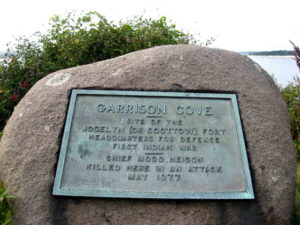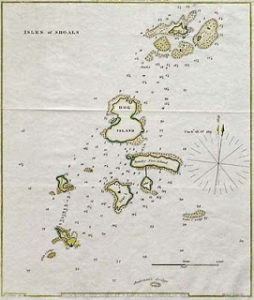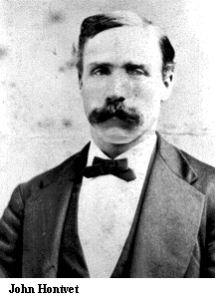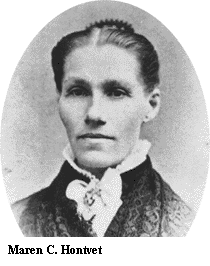Notorious New England Crimes
Contents
Lizzie Borden Took an Axe
by Vaughn Hardacker
Lizzie Borden took an axe
And gave her mother forty whacks
When she saw what she had done
She gave her father forty-oneThe poem, however inaccurate (she was found not guilty, only nineteen blows were counted, the nature of the murder weapon—thought to be a hatchet; not an axe—and the fact that Abby Borden was her step-mother) has kept Lizzie Borden (my 5th cousin, twice removed) a part of Americana since the murders of her father and her step-mother, Abby Durfee Gray Borden, on August 4, 1892 in Fall River, Massachusetts. But few know little more than the poem. So who was Lizzie Borden and why she was considered the prime suspect in a crime for which she was found not guilty on June 20, 1893.Lizzie Andrew Borden (1860 – 1927) was the youngest of three daughters of Andrew Jackson Borden and Sarah Anthony Morse. Her mother died shortly after Lizzie’s birth and Andrew married Abby Durfee Gray, who took over the task of raising his two daughters (Lizzie had an older sister Emma Lenora Borden and there was a middle sister who died at the age of two) and running the household. The Bordens were solid upper-middle class and nowhere near the richest family in Fall River as is generally thought. Lizzie grew up in an atmosphere of idle, not gentile living. She was never to hold a job, although she did volunteer work for church missions, temperance unions and various charities.
Andrew Borden was known to be stingy with a Scrooge-like attitude toward his customers, tenants, and those who borrowed money from him. During her trial, the prosecution attempted to depict Lizzie as a person who would not only kill for an inheritance, but would do so the avenge years of deprivation (both material and psychological) she had endured in her father’s household. There was evidence of friction between the sisters and their father over the way he catered to Abby’s relatives (or so the girls believed). It was during this time that Lizzie stopped calling Abby mother and began calling her “Mrs. Borden.”
Lizzie was considered a suspect in the killings by a number of police officers from the moment they were notified. At the time of the killings only Lizzie, Bridget Sullivan (the Borden’s domestic servant) and the victims were home. It has been thought that Lizzie murdered her step-mother while Bridget was outside the house washing windows. She later told her father that Abby had received a note about a sick friend and she was out of the house. She then encouraged her father to take a nap. Bridget, finished with her chores, went to her room to take a nap. Lizzie said that she then went out to the barn on an errand. According to Lizzie, she returned to the house after hearing a groan, a scraping noise or a call of distress (she related several contradictory stories to the police). Eventually she settled on the story that she went to check on her father and found him slain, his head mutilated.
On August 11th after appearing before an inquest she was arrested for the murders. In December a Grand Jury handed down three indictments against Lizzie Borden: one for the murder of her father, one for the murder of her step-mother, and one for the murder of both. She was removed to a Taunton jail where she remained until her trial in June 1893.
A jury of twelve, mostly Republican men, average age fifty-three, found her not guilty on all counts.
At first public opinion about the verdict was favorable—possibly because it was generally believed that Lizzie would leave Fall River and live someplace where she was less known. She did not, she returned to her home and remained in the city. The absence of closure about the murders caused Lizzie’s and Emma’s position in society to fall. The sisters had become wealthy women because Abby died before Andrew, the step-mother’s family was deprived of her estate and, as a legal matter, it fell into the sisters’s possession. The final blow to her status came when Lizzie (who had a history of stealing) was accused of shoplifting two paintings from a Providence, Rhode Island company. A warrant was never served and the matter was settled privately and Lizzie’s reputation was diminished and she became more isolated.
In 1905, Emma moved out with no public explanation. There is speculation that Emma learned something about the 1892 murders. The sisters never saw nor spoke with each other again.
Lizzie Andrew Borden spent the last twenty-two years of her life an aging spinster surrounded by faithful servants who have never broken their silence. She was quite generous with their salaries and even purchased a house as a residence for some of them.
Lizzie died on June 1, 1927, after suffering complications after a gall bladder operation. Emma died nine days later in Newmarket, New Hampshire. Neither had begotten children so the Andrew Borden branch of the family (the Borden family includes such well-know people as Sir Winston Churchill and Marilyn Monroe) came to an end.
Lizzie’s infamous name has endured and become iconic, spawning numerous books and at least one movie, starring Elizabeth Montgomery as Lizzie. Whether or not she committed the murders or not the unanswered questions continue to fascinate mystery lovers throughout the world.
For more information about Lizzie visit http://www.thelizziebordencollection.com
A Nineteenth Century Scene of a Crime – A Look Back in Time
by Sandra Lee
Crime scene evidence is that which serves to provide clues about the series of events surrounding the commission of a crime. While evidence recovered at crime scenes varies in nature, amounts and probative value, it is all essential to the practice of solving the mysteries at hand. Time has no bearing on the vitality of crime scene evidence, and it is that vitality which commands the use of great care during evidence identification, documentation, collection, analysis and preservation.
During the nineteenth century these functions were all performed locally, and crime scene evidence consisted of whatever the responding authorities decided it should.
Great advancements in sciences and technology during this era granted much efficiency to the processing of crime scenes and even expanded the scope of acceptable forms of evidence. While investigators and scientists in some states fully embraced these innovations, such as the new and evolving arts of fingerprinting and ABO blood-typing, others presented barriers of prejudice and bias, and continued practicing with methods “tried and true”.
Investigators and scientists throughout the Commonwealth of Massachusetts fell into the latter category, due in part to the state’s conservative nature. Other contributing factors toward the resistance of these individuals to be forward-thinking, open-minded and highly-motivated were found on local levels and included low-paying salaries and deficiencies in education and training.
All things considered, one might best define the methods of identifying and collecting crime scene evidence in Massachusetts cities and towns during the nineteenth century as primitive. The 1892 gruesome crime scene at the Borden home in Fall River might best exemplify how the application of aged practices might generate unfavorable results.
In the Borden case a skeleton crew of underpaid, poorly-skilled sleuths failed to immediately secure the scene and a head-to-toe search of the premises wasn’t conducted for days to follow. This ineptitude left much room for the contamination, destruction and/or removal of any evidence not yet collected.
Body temperatures, levels of food digestion and stages of blood drying and coagulation were used to determine the times of death of the victims. This data was gathered with the use of nothing more than human hands and the findings were applied to an ancient suggested set of standards. Clearly, a clinical thermometer would have provided more accurate readings of the body temperatures while the knowledge of, or willingness to recognize new literature available at the time would have altered other findings. The latest studies showed that each of these postmortem events would occur on different levels depending upon human individuality and upon circumstances. Also based on the results of these studies were newly introduced numbers proven to be the standard.
Performances in the lab at a local medical school demonstrated an even broader scope of deficiency in crime scene investigating. Among the evidence ultimately collected were the stomachs of the victims and a hatchet. The stomach linings were searched for scar tissue caused by poisoning because the victims were allegedly ill prior to the murders. Because the hatchet was believed to have caused the fractures in the victims’ skulls, it was studied for the presence of blood. The single instrument used to perform these searches, a magnifying glass, detected no scar tissue, nor did it determine whether a substance found on the hatchet was rust or blood. Some innovative technological and scientific alternatives might have provided more certainty about the evidentiary findings. The spectroscope would have offered significantly more magnification while the introduction of certain metals and minerals to the stomach contents may have detected the presence of poison. Similarly, the simple act of infusing water or fire with the matter on the hatchet would have proven the nature of the substance.
The discounted evidence in the Borden case arguably contained the most probative value. It consisted of the prime suspect, Lizzie’s own damning words. Spoken to a rookie investigator who failed to inform Lizzie of her rights before tuning in, the evidence was deemed inadmissible by the court based on constitutional grounds. Had a more seasoned, forward-thinking investigator interviewed Lizzie, she might have been informed of her rights.
Additionally, the court excluded a local druggist’s statement that Lizzie attempted to buy poison in his store on the day before the murders occurred. Lizzie’s counsel argued that the idea of poisoning was unrelated to the nature of the crimes actually committed. Had the scientist at the lab possessed the knowledge of and willingness to rely upon modern techniques, the druggist’s statement may have been utilized, and Lizzie’s intentions revealed.
Lizzie Borden was acquitted of the murders of her father and stepmother in June of 1893 after just over an hour of deliberation by a twelve-man jury.
Lizzie was exonerated of the crimes based on the evidence both presented and not presented at trial. All evidence in this case was a product of contemporary practices which consisted of widely varying and inconsistent crime scene investigation methods. Many believe a lack of application of common standards based on the best of accepted practices at the time in the gathering and processing of crime scene evidence may have contributed to a guilty person getting away with murder.
Prouts Neck, Maine, USA
by Karla Whitney
Prouts Neck, Scarborough, Maine pokes into the Atlantic Ocean approximately 100 miles northeast of Boston. This bubble shaped peninsula of an estimated 160 acres is home to the Black Point Inn, Winslow Homer House and an exclusive gated community.
Prouts’ bloody history is nearly buried beneath the yacht club, golf course and St. James Episcopal Church. Yet obscured stone markers and nomenclature—Massacre Pond, Cannon Rock, Garrison and Arrowhead Lanes—attest to centuries of conflict. A World War II battery bunker still towers between the summer manses.
Europeans settled Prouts Neck in the early 1600’s by establishing homes, splitting up its acreage and allotting fishing rights. The native Indians who had inhabited the land for thousands of years protested intrusion by attacking the settlers. Retaliations led to wars and by the early 1700’s the indigenous inhabitants had been subdued or erased.
Massacre Pond is an example of the many conflicts.

Captain Richard Hunniwell manned a garrison during the late 1600’s in the remote outpost known as Black Point near Prouts Neck, Maine. This time marked a period of relative peace between the indigenous natives and white settlers. Yet when Captain Hunniwell left Mrs. Hunniwell and their children unguarded, a renegade band of Indians murdered the family to settle a score of past injustices against regional tribes.
In retaliation, the Captain hunted and killed the native Americans with impunity.

File created with CoreGraphics
Revenge was reciprocated on a calm day in 1703. Captain Hunniwell and nineteen men, searching for their missing livestock, were ambushed by natives at the south end of the briny water now known as Massacre Pond. Only one of Hunniwell’s men survived. The mass grave where the slain were buried was visible until the early 1900’s. There are those who attest to the presence of restless spirits roaming the marshes at Massacre Pond, part of present day Scarborough Beach State Park.
Barbarous acts boomeranged between the French and English and the English and New World settlers until the early 1800’s. Less violent present day tensions occasionally flare between locals and summer people, authorities and fishermen, rich and poor.
Inspiration for Winslow Homer, Ed Hopper and other lesser known artists, writers and visitors, Prouts Neck continues as a popular destination for fairy tale weddings and treasured island vacations.
Terror on Smuttynose Island
by Vaughn C. Hardacker
The Islands of the Shoals lie six miles off the coast of Portsmouth, New Hampshire. The island group consists of nine islands, five in Maine and four in New Hampshire, and were named by English explorer Capt. John Smith after sighting them in 1614. The first recorded landfall of an Englishman was that of explorer Capt. Christopher Levett, whose 300 fishermen in six ships discovered that the Isles of Shoals were largely abandoned in 1623.
Smuttynose Island, at 25 acres, is the third-largest island. It is known as the site of Blackbeard’s honeymoon, later for the shipwreck of the Spanish ship Sagunto in 1813, and then for the notorious 1873 murders of two young women. The latter is recalled in the story, “A Memorable Murder”, by Celia Thaxter, in the 1997 novel, The Weight of Water, by Anita Shreve (and in the film of the same name), and in the song, “The Ballad of Louis Wagner” by John Perrault.
 The terrifying events outlined by Thaxter and Shreve took place in the early morning hours of March 6, 1873. The island was inhabited by a single couple, John Honvet and his wife Maren, who arrived there from Norway in 1868. John was a commercial fisherman and he would sail his schooner, the Clara Bella, to the fishing grounds, draw his trawl lines, and then set sail for home in late afternoon. His industriousness earned him respect from his friends and neighbors on other islands (whose population rarely surpassed fifty).
The terrifying events outlined by Thaxter and Shreve took place in the early morning hours of March 6, 1873. The island was inhabited by a single couple, John Honvet and his wife Maren, who arrived there from Norway in 1868. John was a commercial fisherman and he would sail his schooner, the Clara Bella, to the fishing grounds, draw his trawl lines, and then set sail for home in late afternoon. His industriousness earned him respect from his friends and neighbors on other islands (whose population rarely surpassed fifty).
Louis Wagner was working solo, barely eking out a living fishing the waters off the Isles of Shoals when he met Honvet. For two years John and Maren took Wagner, a dark muscular Prussian with a thick accent, under their care, seeing that he was never in need of food or clothing and even went so far as to include him in John’s prosperous business. During the two plus years they were acquainted it is said that Wagner and the Hontvets became as close as brothers and sister.
Though content with their new lives, the Hontvets missed their families in Norway. Maren cherished her small cottage, but often her only companion during John’s absences while fishing was her small dog, Ringe. In May 1871, Maren’s sister, Karen Christensen, arrived from Norway and within a few weeks obtained a position as a live-in maid with a family on nearby Appledore Island (the largest of the Isle of The Shoals islands).
By June of 1872, John’s business had prospered to the point where he was able to hire Wagner, giving him a room within his home. However, in October of that year John found himself with more help than he needed. His brother, Matthew arrived from Norway with Maren’s brother, Ivan Christensen and his wife Anethe. All five family members lived together in the Hontven cottage and Ivan and Matthew went to work with John.
Wagner stayed on for five weeks after Ivan, Matthew, and Anethe arrived and then booked passage as a hand on the Addison Gilbert, a fishing schooner, in November. His luck took a turn for the worse. The Addison Gilbert was wrecked and he found himself reduced to working along the docks in Portsmouth, New Hampshire. He barely made enough money to pay his board. By March of 1873 he was destitute, his shoes and clothes were worn and tattered, and he was behind in his rent.



John, Ivan, and Matthew had set sail early on the morning of March 5, 1873. They placed their trawl lines, intending to sell the catch in Portsmouth and buy bait there, they met a neighbor and asked him to stop by Smuttynose and inform the women that due to a change in the wind direction they would be sailing directly to the mainland.
The women, Maren, Anethe, and Karen (she had left her position on Appledore and taken one as a seamstress in Boston) who was visiting, got the word in the late afternoon.
When the Clara Bella docked in Portsmouth in early evening, Louis Wagner was on hand to help tie the vessel down. He inquired if John and his crew would be returning to Smuttynose that evening. He learned that it depended upon whether or not the bait they wanted to buy was delivered on time. If it was they would return, if not they would stay in port and return home in the morning.
Wagner was last seen in Portsmouth at 7:30 that evening. He learned that the bait had not arrived and decided to burglarize the Hontvet’s home. He stole a dory and rowed into the harbor and out to sea. The feat of rowing twelve miles to the Isles of Shoals was difficult, but not impossible and Wagner was a skilled oarsman, driven by desperation.
The three woman had waited for the men and by 10 PM decided not to do so any longer. They changed into their night clothes and made a bed for Karen in the kitchen, where it was warmer. Maren and Anethe retired to an adjoining bedroom.
Rather than go ashore in the cove where John kept the Clara Bella, Wagner rowed to the far side of the island and disembarked on the rocky shore. He observed the cottage for several hours after the inside lights had gone out. Confident that the women were asleep he made his move. He quickly found the kitchen door unlocked and stepped inside. He jammed a piece of wood into the latch of the bedroom door. His movement aroused the dog and it barked, waking Karen. She asked, “John, is that you?”
Maren then awoke and called to her sister, “Karen? Is something wrong?”
“John scared me!” With that Wagner reached for a chair and struck a incapacitating blow. Karen screamed as he continued his assault.
Karen struggled to her feet and tugged at the bedroom door. Battered and bleeding, she freed the latch and fell at Maren’s feet. Wagner rushed again, now swinging at and hitting both women. Maren managed to pull Karen out of his reach and closed and barricaded the door.
Anethe watched the attack from a corner of the room. Maren implored her to run and hide. Anethe climbed out the bedroom window and stood barefoot in the snow, frozen with fright.
Wagner gave up his assault on the locked door and left the house. In the light of the quarter moon, Maren could see who their attack was. He closed with Anethe and grabbed an axe from its place on the woodpile and with a single motion drove the blade into Anethe’s head. Her lifeless body fell as he continued to strike her. During this horrific attack, Maren was so close that she could have reached through the window and touched him.
Realizing that she could do nothing to help Anethe, Maren turned her attention to saving her sister and herself. She begged Karen to run. Karen, however, was on the verge of fainting and was unable to do anything. By this time Wagner had returned to the house with the axe. Believing both she and her sister would be killed if she remained, Maren wrapped herself in a heavy skirt and, when she heard Wagner return to the house, climbed through the window and ran. She headed for the cove hoping to find Wagner’s boat there. When she did not see it, she ran along the shore to the far side of the island. As she passed the cottage she heard Karen shout in agony. She crawled between two rocks near the water’s edge where the surf obliterated all other sound.
Karen tried to escape through the window but was so weak that it was too much. Wagner finally broke into the room and swung the axe, missing her and hitting the sill, which broke the axe handle. He then twisted a handkerchief around her neck and strangled her until she was dead.
Bloody footprints showed his search for Maren and where he dragged Anethe by her feet into the kitchen. He was exhausted and brewed a pot of tea, leaving blood on the handle, and ate food he had brought using a plate, knife and fork from the Hontvet’s kitchen. He ransacked the house, finding only fifteen dollars and departed, leaving Anethe’s body on the floor beside a clock he had knocked off the mantle—its hands were stopped at seven minutes past one.
It was after eight in the morning when Maren got the attention of the children of Jorge Ingerbredsen, who were playing beside their home on Appledore Island. Jorge rowed across the quarter mile of sea to rescue her. He returned her to his home and with several other men they returned to Smuttynose.
Finding no one on Smuttynose, the men returned home and searched there. A few hours later the Clara Bella was sighted on the horizon and they signaled her. Matthew and Ivan rowed a skiff to Appledore and John sailed the schooner to her moor on Smuttynose. When the men found Maren at the Ingerbredsen house and heard the horrific tale they rushed to Smuttynose, arriving the same time as John. They found the bodies and searched the full contents of their destroyed home, before sailing the schooner to Appledore. That afternoon, John and others carried Maren’s tale of terror to the authorities in Portsmouth.
The stolen dory was found in Newcastle, where two men who knew Wagner reported they had seen him about six o’clock on the morning of March 7, near a place called the Devil’s Den. Wagner had returned to his boarding house, changed some of his clothes and took a 9 AM train to Boston. Wagner was arrested that evening at a boarding house where he had stopped to see some women that he knew. He offered no resistance.
The following day he was transferred from Boston (where a jeering crowd followed—the crime had been widely reported throughout the east coast) to Portsmouth (where a crowd of 10,000 narrowly missed tearing him apart).
Smuttynose falls under the jurisdiction of Maine so Wagner had to be tried there. Three days after arriving in Portsmouth, he was moved from the jail to the train where a lynch mob of over 200 fishermen were waiting. The police escort drew their revolvers and a company of bayonet-wielding Marines were called from the Navy base, but the mob was not easily subdued. The escort was showered with stones and bricks.
Louis Wagner’s trial began in Alfred, Maine on June 9, 1873. It took nine days of testimony and 55 minutes of deliberation for the jury to find him guilty as charged. He broke out of jail within a week, but was recaptured in New Hampshire. On June 25, 1875, 27 months after the crime, Wagner was led into the yard of the state prison in Thomaston, Maine, and hanged. Wagner maintained his innocence to the very end.
Maren and John Hontvet were never to live in the Isles of Shoals again. They moved to Portsmouth, where John continued working as a fisherman. There are two small houses on the island. One of them, the Samuel Haley house, was once believed to be the oldest structure in the state of Maine. Smuttynose is not populated today.

